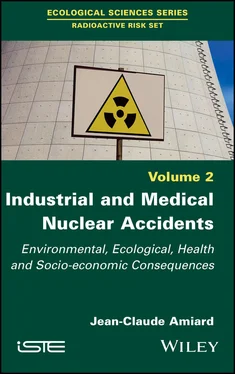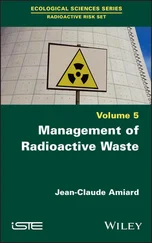1 ...8 9 10 12 13 14 ...17
2.2.4. Spent fuel reprocessing plants
Spent fuel reprocessing plants routinely represent the most polluting step in the fuel cycle [AMI 13a]. These include significant releases of tritium and rare gases (krypton, xenon, etc.) to the atmosphere and many radionuclides to the freshwater and marine environments: fission and activation products as well as transuranics (plutonium, americium). Thus, the activity rates of 129I and the ratios 129I/ 127I in marine samples show the spatial and temporal influence of the La Hague site on its near environment as well as on a regional scale along the Channel coast [FRE 03].
Only a few countries, France (La Hague), Japan (Tokai-Mura and then Rokkasho-Mura), United Kingdom (Sellafield) and Russia (Ozersk), have developed this stage and have reprocessing plants. The United States shut down its West Valley plant in 1972. The main accidents or incidents will be described below in chronological order. The largest number of them concerns THORP (Sellafield’s plant).
2.2.4.1. French accidents at La Hague
Before the two most serious accidents, a first accident occurred in the La Hague fuel reprocessing plant on October 2 and 3, 1968. It resulted in an atmospheric release of 185.10 9Bq of iodine 131 (Scheidhauer et al ., 1971, in [AMI 80]).
The breakage in the offshore discharge pipeline from the La Hague reprocessing plant
The estimated date of this breakage was between early September and late November 1979. This resulted in an increase in radioactivity in the marine environment (seawater, sediments, algae, mollusks, crustaceans, fish) of many radionuclides ( 90Sr, 106Ru, 137Cs, 238Pu, 239Pu, 244Cm) between 1980 and 1981 [GRN 99, BAR 00]. For example, for 90Sr in 1979, 1980 and 1981 respectively, the concentrations in sediments were 122, 823 and 71 Bq.kg −1wet weights and those in mollusks were 41, 274 and 24 Bq.kg −1wet weights.
The fire at silo 130 at the La Hague facility
On January 6, 1981, a fire broke out in silo 130 of the La Hague plant, where waste from the reprocessing of spent fuel from the “natural uranium-natural graphite-gas” process was stored in the UP2-400 plant, causing cesium 137 to be released into the environment for several hours. It took more than 24 hours to control this fire [JAC 14].
Between 1973 and 1981, silo 130 received a total of 518 tons of waste, mainly graphite, magnesium and uranium. The radioactive substances present in silo 130 were mainly the activation products contained in graphite liners and magnesium caps after their passage through the reactor, and the fission products (in particular cesium 137) contained in uranium metal after their passage through the reactor and uranium metal. In addition, between December 11 and 15, 1980 (a few days before the fire), cotton used for decontamination operations (cotton soaked in phosphate degreaser) was dumped into the silo.
The last waste container was emptied into silo 130 on January 5, 1981 at 6:30 p.m. It mainly contained magnesium caps and uranium metal. Between recovery and disposal in silo 130, this waste remained dry for several days, but previously the last waste dumped was uranium from a water pit. The most plausible hypothesis is that this uranium, which is most likely present in the form of hydride (UH3) as a result of its prolonged contact with water, is highly pyrophoric, especially when it has been dry for several days, which was the case here.
On January 6, 1981, at 4:00 a.m., air contamination was detected approximately 800 meters from silo 130 at the AT1 building. Cesium 137 was mainly present in these discharges, which directed research attention towards the silo.
The resulting contamination inside the site on about one hectare affected building 130 overlooking the silo and outside areas. The maximum values recorded were 111.10 3Bq. m- 2in cesium 137. Off-site, contamination remained low and did not exceed 3.7.10 2Bq.m −2in cesium 137 [JAC 14].
Silo 130 now contains the same substances as those present at the time of the fire, as well as effluents from fire suppression (600 m 3) and rainwater infiltration (800 m 3). It will be necessary to dismantle this silo despite all the difficulties involved.
2.2.4.2. Accident in Tokai-Mura
The first nuclear accident at the Tokai-Mura reprocessing plant occurred on March 11, 1997 at the Dōnen (Power Reactor and Nuclear Fuel Development Corporation) spent fuel reprocessing plant. A small explosion occurred during the night, exposing between 35 and 40 workers to unusual radiation doses.
2.2.4.3. Incidents and accidents in Sellafield
The Sellafield site is the main complex of the British nuclear power sector. Originally named Windscale, it was renamed Sellafield following the serious accident at battery 1 involving plutonium for military use in 1957 [AMI 19]. The site borders the Irish Sea in the county of Cumbria in north-west England, near the town of Seascale. It now includes 400 buildings spread over 10 km 2and employs about 10,000 people. Among the facilities is a fuel processing and high-level waste storage plant called THORP (Thermal Oxide Reprocessing Plant). It is designed to process both British and foreign fuels using a different process than the one used at La Hague (PUREX).
A first level 3 incident occurred in 1992 with the release of nitrated plutonium into a containment cell in the fuel reprocessing facility.
On April 19, 2005, 83,000 liters of radioactive material were discovered in a reinforced concrete enclosure at this plant, which followed a pipeline rupture that had not been detected for several months. About 200 kg of plutonium in nitric acid solution had flowed along a tank and accumulated in a drip pan (large collection tank for flow fluids) with a risk of criticality accident. The investigation concluded that the uranium and plutonium had flowed for about 9 months on the ground and then into a sump. The British Safety Council (HSE/ND4) has published a 28-page report [HSE 05]. The company, prosecuted for non-compliance with three authorizations concerning “safety, mechanisms, devices and circuits”, “operating instructions” and “leaks and losses of radioactive materials or radioactive waste”, had to pay £500,000 in fines plus approximately £68,000 in procedural costs. About 19 tons of uranium and 160 kg of plutonium (out of 200 kg according to the IRSN [IRS 12a]) dissolved in nitric acid were recovered by pumping into the reservoir’s sump outside the plant. According to the IRSN ([IRS 12a]), these failures were caused by “excessive confidence in the plant design” and “an insufficient safety culture”. The accident was classified as a level 3 accident on the INES. A similar plant in La Hague has modified its procedures to prevent this type of accident.
As a result of this accident, the THORP was closed from April 2005 to July 2007 and will be finally closed in 2018 after the completion of contracts, and then dismantled.
2.2.4.4. Accident in Russia in September 2017
The IRSN [IRS 17c], as well as several Western European networks, have detected high concentrations of ruthenium 106 in the air. In France, the maximum concentration was measured in Nice between October 2 and 9, 2017 (46 μBq.m −3). By reverse modeling, the IRSN estimated that the accident site was located between the Volga and the Urals rivers and the date was the last week of September 2017. The quantity released was significant, in the range of 100–300 TBq. With 106Ru being an artificial fission product, three accidental sources are possible: first, leakage came from a spent fuel reprocessing plant; second, leakage came from a ruthenium-based radioactive source manufacturing plant; third, it could even be from the possible fall of a satellite powered by a nuclear reactor based on this radionuclide. With the final hypothesis being refuted by the IAEA, one of the other two possibilities is the most likely. The accident site is close to the Mayak complex, where the Kyshtym military accident occurred [AMI 19].
Читать дальше












